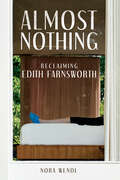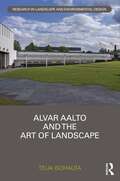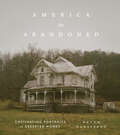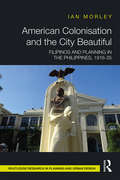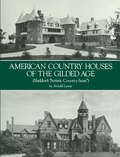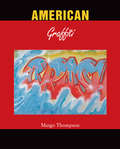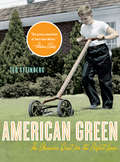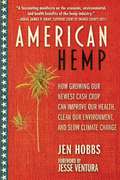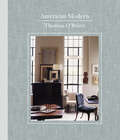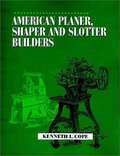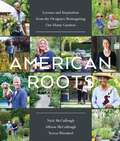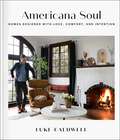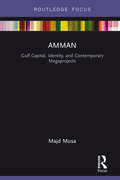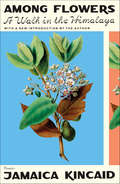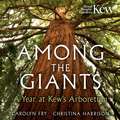- Table View
- List View
Almost Nothing: Reclaiming Edith Farnsworth
by Nora WendlThe iconic Edith Farnsworth House is a singular glass home designed by Mies van der Rohe. But the oft-told history of the house overwrites Farnsworth’s role as Mies’s collaborator and antagonist while falsely portraying her as the architect’s angry ex-lover. Nora Wendl’s audacious work of creative nonfiction explodes the sex-and-real-estate myth surrounding the Edith Farnsworth House and its two central figures. An eminent physician and woman of letters, Farnsworth left a rich trove of correspondence, memoirs, and photographs that Wendl uses to reconstruct her voice. Farnsworth’s memories and experiences alternate with Wendl’s thoughts on topics like misogyny and professional ambition to fashion a lyrical examination of love, loneliness, beauty, and the search for the divine. Eloquent and confessional, Almost Nothing restores Edith Farnsworth to her place in architectural history and the masterpiece that bears her name.
Alquimia Dos Óleos Essenciais
by Adidas WilsonÓleos essenciais têm qualidade variável. Se você é um aromaterapeuta ou um consumidor, avaliar a qualidade dos óleos essenciais (EOs) não é fácil. Eles são originários de todo o mundo e empresas, ou fornecedores obtê-los de atacadistas ou agricultores cuja integridade e práticas aprenderam a confiar. O consumidor final não tem ideia e não pode avaliar essas práticas e relacionamentos.
Altars: Bringing Sacred Shrines into Your Everyday Life
by Denise LinnTFrom the book: he urge to create sacred spaces is so deep in the human psyche that we often create them unconsciously. A gathering of photos on a piano, an arrangement of personal objects on a desk or fireplace mantel, are perhaps outer manifestations of an inner desire to establish hallowed and holy spaces in our environment. Denise Linn, the internationally acclaimed author of Sacred Space, speaks directly to this primal longing for sacred places. In Altars, she demonstrates in photos and text how you can enrich your home or office by creating unique shrines for healing and contemplation. Beautifully illustrated and thoroughly practical, Altars shows how to Create personal altars for devotion, transitions in life, manifestation, and love Choose the optimum place to locate your home altar, according to the points of the compass and the ancient principles of feng shui Select altar objects that are particularly suited to your special needs Purify yourself and your altars with incense, prayers, drumming, and chanting Everyone who yearns to enter into the mysterious and wondrous realms, to infuse ordinary moments with sacred meaning, will find a great abundance of beauty, inspiration, and wisdom in this unique book. Renowned lecturer, author, and visionary Denise Linn has researched spiritual practices from cultures throughout the world for more than twenty-nine years. Calling upon this wealth of knowledge, she originated the unique and groundbreaking feng shui system Interior Alignment . Her synthesis of practical information and spirituality has had a deep impact on thousands of participants worldwide. She is also the author of nine books, including Sacred Legacies, The Secret Language of Signs, Quest, and the international bestseller Sacred Space. Includes appendices which explain the meanings (traditionally) of items frequently used on altars: stones, shells, flowers, herbs and more.
Alvar Aalto and The Art of Landscape (Routledge Research in Landscape and Environmental Design)
by Teija IsohautaAlvar Aalto and The Art of Landscape captures the essence of the Finnish architect’s landscape concept, emphasising culture and tradition, which characterised his approach to and understanding of architecture as part of the wider environment. From the forests of his youth to sights from his travels, Alvar Aalto (1898–1976) was influenced by outdoor landscapes. Throughout his career, he felt the need to shape the terrain and this became a signature of his architecture. Divided into five chapters, this book traces Aalto’s relationship with landscape, starting with an analysis of his definitions and descriptions of landscape language, which ranged from natural references and biological terms, to synonyms and comparisons. It includes beautifully illustrated case study projects from the 1950s and 1960s, discussing Aalto’s transformation of different landscapes through topography, terracing and tiers, ruins and natural elements, horizon outlines, landmarks, and the repetition of form. Featuring archival sketches, garden drawings, and plans, the book also contains Aalto’s text ‘Architecture in the Landscape of Central Finland’ from 1925 in the appendix. This book provides fascinating, untold insights into Aalto’s relationship with landscape and how this developed during his lifetime, for scholars, researchers, and students interested in architecture and landscape history, landscape art, and cultural studies.
America the Abandoned: Captivating Portraits of Deserted Homes
by Bryan SansiveroPeer into the mysterious world of abandoned homes across the United States with this fascinating photography book—a visual exploration of what makes up a life, and what we leave in our wake. Photographer Bryan Sansivero has been uncovering abandoned homes for more than a decade, traveling across the country to capture them on film before they crumble completely, never sure of what he might find. Sansivero documents the inhabitants&’ everyday living rooms, kitchens, and bedrooms just as he found them, showcasing their unique furniture, clothing, books, appliances, toys, artwork, and other personal items, which often appear as if the owners were just there a moment ago. The stories of the former tenants remain mostly unknown, but the images are haunting time capsules, and a reminder that everything we own is temporary, and eventually will be left behind or forgotten. There is an element of mystery and eeriness that this imagery evokes. In addition to those who are entranced by beautiful coffee table books, America the Abandoned will entice those who love horror films and books—from Stranger Things to The Shining.
American Architects and the Single-Family Home: Lessons Learned from the Architects' Small House Service Bureau
by Lisa M. TuckerAmerican Architects and the Single-Family Home explains how a small group of architects started the Architects’ Small House Service Bureau in 1919 and changed the course of twentieth-century residential design for the better. Concepts and principles they developed related to public spaces, private spaces, and service spaces for living; details about the books they published to promote good design; as well as new essays from contemporary practitioners will inspire your own designs. More than 200 black and white images.
American Barns
by Jan ArnettThe heart of every working farm and ranch, the barn is an icon of rural America. This book chronicles - and celebrates - all the main types, and looks at how these treasures of early American architecture developed. It explains how a wealth of immigrant construction methods and range of environments and climates resulted in a fascinating variety of barn styles in the United States, from the earliest rare Dutch examples to simpler English types and others in more surprising shapes (round or even polygonal) crafted by the Shakers in the 1800s. It highlights the most notable, famous and historic barns that the reader can visit, and features highlights the efforts of conservation groups to preserve America's barns and find innovative ways to repurpose these glorious old structures as homes and studios--and as living monuments of rural heritage.
American Colonisation and the City Beautiful: Filipinos and Planning in the Philippines, 1916-35
by Ian MorleyAmerican Colonisation and the City Beautiful explores the history of city planning and the evolution of the built environment in the Philippines between 1916 and 1935. In so doing, it highlights the activities of the Bureau of Public Works’ Division of Architecture as part of Philippine national development and decolonisation. Morley provides new archival materials which deliver significant insight into the dynamics associated with both governance and city planning during the American colonial era in the Philippines, with links between prominent American university educators and Filipino architecture students. The book discusses the two cities of Tayabas and Iloilo which highlight the significant role in the urban design of places beyond the typical historiographical focus of Manila and Baguio. These examples will aid in further understanding the appearance and meaning of Philippine cities during an important era in the nation’s history. Including numerous black and white images, this book is essential for academics, researchers and students of city and urban planning, the history and development of Southeast Asia and those interested in colonial relations.
American Country Houses of the Gilded Age: (Sheldon's "Artistic Country-Seats") (Dover Architecture)
by A. LewisThe "Gilded Age," the three decades following the Civil War, were years of astounding economic growth. Vast empires in oil, shipping, mining, banking, lumber, transportation, and related industries were formed. It was an era in which fortunes were made and lost quickly, almost easily; a period that encouraged - nearly demanded - the public display of this newly acquired wealth, power, and prestige. It was during these heady, turbulent years that a new type of domestic architecture first appeared on the American landscape. Called the "country seat" or "cottage," these houses were grandiose in scale - imposing facades complemented by manicured gardens, with exceptionally large and impressive reception rooms, halls, parlors, dining rooms, and other public areas. Intended exclusively for the very well-to-do, these buildings were designed by some of the finest and most influential architectural firms in America: McKim, Mead & White; Bruce Price; Peabody & Stearns; Theophilus P. Chandler, Jr.; Lamb & Rich; Wilcox & Johnston; and many others. The first, best, and most exquisite documentation of this surge of architectural creativity was the 1886-87 publication of George William Sheldon's Artistic Country-Seats: Types of Recent American Villa and Cottage Architecture with Instances of Country-Club Houses. It presented exceedingly fine photographs, clearly detailed plans and elevations, as well as Sheldon's own commentary for a total of 97 buildings (93 houses and 4 casinos). Most structures were located in new England and the Middle Atlantic states, and embraced the full spectrum of architectural and artistic expressions. This present volume reproduces all of Sheldon's fascinating and historically important photographs and plans, and adds a new, thoroughly accurate text by Arnold Lewis (Professor of Art, the College of Wooster, Wooster, Ohio) that includes the most useful information supplied by Sheldon and also reports on the present condition of each house or casino, providing analyses of elevations and plans, observations about family life in the 1880s, and brief biographical comments about the clients and architects. Sheldon's photographs connect us with a time and style of living that today increasingly seem more the realm of fiction than fact. Yet, in the pages of this important collection, they are brought fresh to life as they appeared when they were new and times were very different.
American Eden: From Monticello to Central Park to Our Backyards
by Wade GrahamThe story of our nation and ourselves as told through our country's most significant gardens and their creators. From Frederick Law Olmsted to Richard Neutra, Michelle Obama to our neighbors, Americans throughout history have revealed something of themselves--their personalities, desires, and beliefs--in the gardens they create. Rooted in the time and place of their making, as much as in the minds and identities of their makers, gardens mirror the struggles and energies of a changing society. Melding biography, history, and cultural commentary in a one-of-a-kind narrative, American Eden presents a dynamic, sweeping look at this country's landscapes and the visionaries behind them. Monticello's gardens helped Jefferson reconcile his conflicted feelings about slavery-and take his mind off his increasing debt. Edith Wharton's gardens made her feel more European and superior to her wealthy but insufficiently sophisticated countrymen. Martha Stewart's how-to instructions helped bring Americans back into their gardens, while at the same time stoking and exploiting our anxieties about social class. Isamu Noguchi's and Robert Smithson's experiments reinvigorated the age-old exchange between art and the garden. American Eden offers an inclusive definition of the garden, considering intentional landscapes that range from domestic kitchen gardens to city parks and national parks, suburban backyards and golf courses, public plazas and Manhattan's High Line park, reclaimed from freight train tracks. And it exposes the overlap between garden-making and painting, literature, and especially architecture-the garden's inseparable sibling-to reveal the deep interconnections between the arts and their most inspired practitioners. Moving deftly through time and place across America's diverse landscapes--from Revolutionary-era Virginia to turn-of-the-century Chicago to 1960s suburban California--and featuring a diverse cast of landscape-makers--whether artists, architects, or housewives, amateurs or professionals, robber barons, politicians, reformers, or dreamers--Wade Graham vividly unfolds the larger cultural history through more personal dramas. Beautifully illustrated with color and black-and-white images, American Eden is at once a different kind of garden book and a different kind of American history, one that offers a compelling, untold story--a saga that mirrors and illuminates our nation's invention, and constant reinvention, of itself.
American Graffiti
by Margo ThompsonDepuis le début des années 1970, les graffeurs décorent l'extérieur des rames de métro avec des tags toujours plus grands et toujours plus élaborés. Dans le schéma primitiviste, les graffeurs, en tant qu'artistes en marge, offraient de nouvelles perspectives à la société américaine. Ils tendaient un miroir à la culture hégémonique. Les références aux médias ou à des elements culturels que les artistes intégraient dans leurs créations revêtent aujourd'hui une importance toute particulière, parce qu'elles représentent un point de contact entre les cultures et ont rendu cette « sousculture » plus accessible à son nouveau public. Cette forme d'expression résolument rebelle est ici analysée par Margo Thompson qui met en relation l'art du graffiti avec l'art contemporain. Tout comme les graffeurs apportaient une voix à une classe ethnique sous-représentée, l'auteur, grâce à une thèse originale, tend à servir d'ambassadrice à cette forme d'art souvent méconnue.
American Green: The Obsessive Quest For The Perfect Lawn
by Ted Steinberg“Ted Steinberg proves once again that he is a master storyteller as well as our foremost environmental historian.”—Mike Davis The rise of the perfect lawn represents one of the most profound transformations in the history of the American landscape. American Green, Ted Steinberg's witty exposé of this bizarre phenomenon, traces the history of the lawn from its explosion in the postwar suburban community of Levittown to the present love affair with turf colorants, leaf blowers, and riding mowers.
American Grown: The Story of the White House Kitchen Garden and Gardens Across America
by Michelle ObamaIn April 2009, First Lady Michelle Obama planted a kitchen garden on the White House's South Lawn. As fresh vegetables, fruit, and herbs sprouted from the ground, this White House Kitchen Garden inspired a new conversation all across the country about the food we feed our families and the impact it has on the health and well-being of our children. Now, in her first-ever book, American Grown, Mrs. Obama invites you inside the White House Kitchen Garden and shares its inspiring story, from the first planting to the latest harvest. Hear about her worries as a novice gardener - would the new plants even grow? Learn about her struggles and her joys as lettuce, corn, tomatoes, collards and kale, sweet potatoes and rhubarb flourished in the freshly tilled soil. Get an unprecedented behind-the-scenes look at every season of the garden's growth, with striking original photographs that bring its story to life. Try the unique recipes created by White House chefs and made with ingredients just picked from the White House garden. And learn from the White House Garden team about how you can help plant your own backyard, school or community garden. Mrs. Obama's journey continues across the nation as she shares the stories of other gardens that have moved and inspired her: Houston office workers who make the sidewalk bloom; a New York City School that created a scented garden for the visually impaired; a North Carolina garden that devotes its entire harvest to those in need; and other stories of communities that are transforming the lives and health of their citizens. In American Grown, Mrs. Obama tells the story of the White House Kitchen Garden, celebrates the bounty of gardens across our nation, and reminds us all of what we can grow together.
American Hemp: How Growing Our Newest Cash Crop Can Improve Our Health, Clean Our Environment, and Slow Climate Change
by Jen HobbsIf there ever was a time to build an American hemp industry, the time is now.In Jesse Ventura’s Marijuana Manifesto, former Minnesota Governor teamed up with Jen Hobbs to explain why it’s time to fully legalize cannabis and end the War on Drugs. Through their research, it became clear that hemp needed its own manifesto. Jen Hobbs takes up this torch in American Hemp.December of 2018 marked a largely unprecedented victory for cannabis. The 2018 Farm Bill passed and with it hemp became legal. What the federal government listed for decades as a schedule 1 narcotic was finally classified as an agricultural crop, giving great promise to the rise of a new American hemp industry. Filled with catchall research, American Hemp examines what this new domestic crop can be used for, what makes it a superior product, and what made it illegal in the first place; the book also delves into the many health and medical benefits of the plant. Hobbs weighs in on how hemp can improve existing industries, from farming to energy to 3D printing, plus how it can make a serious impact on climate change by removing toxins from the soil and by decreasing our dependence on plastics and fossil fuels.American Hemp lays out where we are as a nation on expanding this entirely new (yet ancient) domestic industry while optimistically reasoning that by sowing hemp, we can grow a better future and save the planet in the process.
American Modern
by Thomas Obrien“One of those designers whose interior and furniture designs look discovered, not created . . . both comfortable and exquisite, calm and eclectic.” —Apartment TherapyDesigner and merchant, collector and tastemaker, Thomas O’Brien has made a career of translating cool notions of modernism into an easy and generous array of modern styles that anyone can attain. Now he introduces readers to a range of those styles—from casual to formal, vintage to urban—alongside stunning photography and charming design stories.O’Brien carefully describes the design process of his chosen projects, including a downtown New York City loft, a traditional Connecticut estate, and a converted schoolhouse in eastern Long Island. Each home explores a view on the modern design spectrum he has created, as well as the individual choices that make the design unique and its mix essentially American. He explains not only what was at work to create a given style, but how readers can import those practices to their own homes and personal design sensibilities. Important design principles such as architectural authenticity, color relationships, correctness of scale, and informed collecting are threaded through a practical narrative that reads like a master class in interior design. American Modern is an inspiring design volume that will redefine the way readers think about modern interiors.“O’Brien carefully describes the design process of his chosen projects. Beautiful imagery and a unique layout describe his approach to design in a new and innovative way.” —LIFEMSTYLE“It’s like getting a glimpse into the studio paintings of a great master . . . I especially love how all of his spaces feel so gender neutral, the perfect balance.” —Cottage Farm
American Planer, Shaper and Slotter Builders
by Kenneth L. CopeHere is the first book to identify American builders of planers, shapers and slotters, who operated throughout the 19th and early 20th centuries. Written in the style of the author?s previous groundbreaking books on the American machine tool industry, this volume provides the reader with invaluable information on over 300 makers. Some are very well known, but many have previously gone virtually unrecognized by researchers. More than 1000 illustrations, taken from original catalogs and contemporary periodicals, show how these machines developed: starting out in the early 1800s as crude, hand-built copies of English machines and becoming, over the course of a century, monster machines weighing nearly one million pounds, unmatched elsewhere in the world. Numerous machine accessories, such as chucks, dividing heads, milling attachments and keyseating attachments, among others, are identified and illustrated. In addition, the book includes a glossary of terms used in describing the various types of planers, shapers and slotters, and provides illustrations that help identify the individual parts of the machines.
American Profile Hometown Cookbook: A Celebration of America's Table
by Mary Carter Susan Fisher Candace Floyd"In this extraordinary cookbook, you'll find traditional American favorites with a unique twist alongside ethnic creations from around the world. Also included are helpful tips from American Profile's test kitchen as well as 30 articles on hometown festivals and fairs across the nation that give you a sneak peek into the lives of the ordinary citizens that make up hometown America. Whether it's a simple soup for the family or a full meal for visitors, the American Profile Hometown Cookbook has just the right recipe to make any gathering a special occasion."
American Roots: Lessons and Inspiration from the Designers Reimagining Our Home Gardens
by Nick McCullough Allison McCullough Teresa Woodard&“I love this book. Here are home gardens of designers from every part of our great country that are inspiring proof of a passionate vitality and freshness in American gardening today.&” — Page Dickey, author of Uprooted In recent years, bold designers have begun championing an American design aesthetic that embraces regional cultures, plants, and growing conditions. In American Roots, Nick McCullough, Allison McCullough, and Teresa Woodard highlight designers and creatives with exceptional home gardens, focused on those who push the boundaries, trial extraordinary plants, embrace a regional ethos, and express their talents in highly personal ways. Covering all the regions of the country, the profiles dive into design influences, share the back stories of the gardens and their creators, and include design tips and plant suggestions. American Roots is a beautiful invitation to reconsider how we define the American garden, filled with guidance and encouragement for anyone looking to dig more deeply into their own home garden.
Americana Soul: Homes Designed with Love, Comfort, and Intention
by Luke CaldwellEnter the world of Luke Caldwell, founder of the Timber and Love design and build firm and HGTV star of Boise Boys and Outgrown, as he shares his intentional design philosophy for creating timeless and organic home designs in this aspirational and accessible book.If you&’ve seen the popular HGTV shows Boise Boys and Outgrown, you&’ll know Luke Caldwell&’s passion for natural materials and comfortable spaces that are warm, inviting, livable, and beautiful at the same time. Now with Americana Soul, you can make those designs work for you. Organized by design style—Timber and Love, Natural and Organic, and Classic and Cozy—Luke&’s book is filled with photography that showcases the bones and flow of the spaces as well as the details that make them unique. Americana Soul showcases Luke&’s passion for design including curated personal collections and vintage finds, natural stone walls and fireplaces, and exposed wood beams, in a way that will inspire you to create your own.
Amish Garden: A Year In The Life Of An Amish Garden
by Laura A. LappAn Amish Garden: A Year in the Life of an Amish Garden takes you to six working Amish gardens, from January through December. Matchless photos show the garden asleep, the Amish women putting together their orders for seeds, the preparation of the soil, parents and children planting, the emerging plants, the lush harvest, the food being preserved. This close-up of a world seldom seen shows how the seasons and Amish life work rhythmically together. Laura Anne Lapp lives with her husband and three young sons in a tucked-away valley. Gardening is simply the highpoint of her year. Step apart and enter this pastoral world of hard work, sturdy families, the freshest of flowers and produce, all in harmony with the seasons.
Amman: Gulf Capital, Identity, And Contemporary Megaprojects (Built Environment City Studies)
by Majd MusaGulf capital flows to Amman, Jordan, in the early twenty-first century and the investment of this capital in large-scale urban developments have significantly transformed the city’s built environment. Therefore, to understand urban transformation in Amman during this period it is important to analyze it against the backdrop of Gulf capital and its integration into Jordan’s economy and the integration of both the country’s economy and Gulf capital into the global capitalist economy. This book analyzes three cases of megaprojects planned for the city in the early twenty-first century: The New Downtown (Abdali), Jordan Gate, and Sanaya Amman. Drawing upon theories on urban development and capitalism, identity, and discourse, and urban development processes and cases in other cities, the book investigates how contemporary megaprojects in Amman fit into the capitalist economy and its modes of production, how capital flows construct a modern image of the city, and how the new image and megaprojects represent the city residents as modern and create Amman as a global city. This book presents a new approach to the study of the urban built environment in Amman, providing a valuable interdisciplinary contribution to the scholarly work on globalizing cities, especially in the Middle East.
Among Flowers: A Walk in the Himalaya (National Geographic Directions Ser.)
by Jamaica KincaidIn this travel memoir, the acclaimed novelist Jamaica Kincaid chronicles a three-week trek through Nepal, the spectacular and exotic Himalayan land, where she and her companions are gathering seeds for planting at home. The natural world and, in particular, plants and gardening are central to Kincaid’s work; in addition to such novels as Annie John and Lucy, Kincaid is the author of My Garden (Book): a collection of essays about her love of cultivating plants and gardens throughout her life. Among Flowers intertwines meditations on nature and stunning descriptions of the Himalayan landscape with observations on the ironies, difficulties, and dangers of this magnificent journey.For Kincaid and three botanist friends, Nepal is a paradise, a place where a single day’s hike can traverse climate zones, from subtropical to alpine, encompassing flora suitable for growing at their homes, from Wales to Vermont. Yet as she makes clear, there is far more to this foreign world than rhododendrons that grow thirty feet high. Danger, too, is a constant companion—and the leeches are the least of the worries. Unpredictable Maoist guerillas live in these perilous mountains, and when they do appear—as they do more than once—their enigmatic presence lingers long after they have melted back into the landscape. And Kincaid, who writes of the looming, lasting effects of colonialism in her works, necessarily explores the irony of her status as memsahib with Sherpas and bearers.A wonderful blend of introspective insight and beautifully rendered description, Among Flowers is a vivid, engrossing, and characteristically frank memoir from one of our most striking voices.
Among the Giants: A Year at Kew's Arboretum
by Kew GardensStretching across two-thirds of the Gardens, the arboretum at Kew surrounds the glasshouses in a leafy enclave to walk, wander and discover nature's beauty. The 12,000 trees rooted in the arboretum represent more than 2,000 species, including rare and ancient varieties. This great collection contains trees as old as the Gardens themselves, many that cannot be found anywhere else in Britain.But who looks after these vast landscapes?Introducing the Tree Gang - Kew's team of eight who work tirelessly throughout the year to maintain this rare collection.In this new book from Kew, you'll discover the fascinating work of the Tree Gang: the team of eight that care for the trees at Kew. Going behind the scenes, you'll learn more about life at Kew from the people who tend and care for the Gardens - from the daily tree assessments to the intermittent tree felling. As the climate becomes more variable, the gang's work is ever more crucial as they brace for the storms ahead.AMONG THE GIANTS weaves together heartwarming stories alongside the fascinating life of trees. This book will inspire you to learn from the experts, and grow an appreciation for the trees around you.
Among the Giants: A Year at Kew's Arboretum
by Kew GardensStretching across two-thirds of the Gardens, the arboretum at Kew surrounds the glasshouses in a leafy enclave to walk, wander and discover nature's beauty. The 12,000 trees rooted in the arboretum represent more than 2,000 species, including rare and ancient varieties. This great collection contains trees as old as the Gardens themselves, many that cannot be found anywhere else in Britain.But who looks after these vast landscapes?Introducing the Tree Gang - Kew's team of eight who work tirelessly throughout the year to maintain this rare collection.In this new book from Kew, you'll discover the fascinating work of the Tree Gang: the team of eight that care for the trees at Kew. Going behind the scenes, you'll learn more about life at Kew from the people who tend and care for the Gardens - from the daily tree assessments to the intermittent tree felling. As the climate becomes more variable, the gang's work is ever more crucial as they brace for the storms ahead.AMONG THE GIANTS weaves together heartwarming stories alongside the fascinating life of trees. This book will inspire you to learn from the experts, and grow an appreciation for the trees around you.
Among the Giants: A Year at Kew's Arboretum
by Kew GardensStretching across two-thirds of the Gardens, the arboretum at Kew surrounds the glasshouses in a leafy enclave to walk, wander and discover nature's beauty. The 12,000 trees rooted in the arboretum represent more than 2,000 species, including rare and ancient varieties. This great collection contains trees as old as the Gardens themselves, many that cannot be found anywhere else in Britain.But who looks after these vast landscapes?Introducing the Tree Gang - Kew's team of eight who work tirelessly throughout the year to maintain this rare collection.In this new book from Kew, you'll discover the fascinating work of the Tree Gang: the team of eight that care for the trees at Kew. Going behind the scenes, you'll learn more about life at Kew from the people who tend and care for the Gardens - from the daily tree assessments to the intermittent tree felling. As the climate becomes more variable, the gang's work is ever more crucial as they brace for the storms ahead.AMONG THE GIANTS weaves together heartwarming stories alongside the fascinating life of trees. This book will inspire you to learn from the experts, and grow an appreciation for the trees around you.
